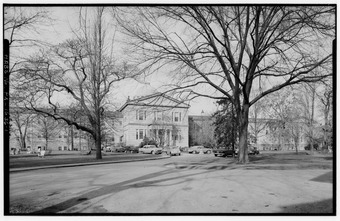Institute of the Pennsylvania Hospital facts for kids
|
Institute of Pennsylvania Hospital
Kirkbride's Hospital |
|

Market Street facade in 1959.
|
|
| Location | 111 North 49th Street, Philadelphia, Pennsylvania |
|---|---|
| Built | 1841; 1859 |
| Architectural style | Neoclassical |
| NRHP reference No. | 66000684 |
Quick facts for kids Significant dates |
|
| Added to NRHP | October 15, 1966 |
| Designated NHL | June 23, 1965 |
The Institute of Pennsylvania Hospital, also known as Kirkbride's Hospital, was a special hospital for people needing mental health care. It was located in Philadelphia, Pennsylvania. This hospital was very important because it changed how people with mental illnesses were treated.
It opened in 1841 and operated until 1997. The main building that still stands today is called the Kirkbride Center. It is now part of the Blackwell Human Services Campus. The hospital campus was very large, covering several blocks along Market Street.
Contents
A New Way to Help People
The hospital's first leader was Thomas Story Kirkbride. He was a doctor and superintendent. Kirkbride believed in a kinder way to treat people with mental illnesses. His ideas became very popular. The hospital's design and treatment methods became a model for many other hospitals across the United States. The main building, built in 1859, is now a National Historic Landmark. This means it is a very important historical place.
How It Started
In the late 1830s, the people running Pennsylvania Hospital decided to build a new, larger hospital. This was to replace their old, crowded wards for people with mental health issues. They chose a big piece of land, about 101 acres, in West Philadelphia.
The first building for the Pennsylvania Asylum for the Insane was finished in 1841. It was designed by Isaac Holden. This new hospital offered a much better way of care. Unlike many other places where patients might be chained or kept in bad conditions, here they had private rooms. They received medical treatment and could work outdoors. They also enjoyed fun activities like lectures and using the hospital library. Because of Dr. Kirkbride's work, the hospital soon became known as "Kirkbride's Hospital."
The Kirkbride Plan
Dr. Thomas Kirkbride studied other good hospitals to develop his ideas. He also used his own strong beliefs about mental health. From his experience, he created the Kirkbride Plan. This plan was a special design for mental hospitals. It was used all over the United States during the 1800s.
He wrote a detailed book about his system in 1854. It was called On the Construction, Organization, and General Arrangements of Hospitals for the Insane. His plan focused on creating a healthy and calming environment for patients.
A Second Building
By the 1850s, the first hospital building became too crowded. Dr. Kirkbride asked the hospital managers for another building. This gave him a chance to build a hospital exactly how he wanted it. The new building was for male patients. It was built along 49th Street.
Finished in 1859, this huge building had many wings coming out from a central part. It was very new and improved. It had lots of space, fresh air, and natural light. These ideas were copied in many other hospitals. A young architect named Samuel Sloan, who was Kirkbride's friend, designed this building in the Neoclassical style.
Changes Over Time
Mental health services at the hospital continued to grow through the 1800s and early 1900s. However, by the mid-1900s, the first hospital building from 1841 was no longer useful. It was taken down in 1959. All patient care then moved to the newer building from 1859. This 1859 building was recognized as a National Historic Landmark in 1966.
The hospital was located in the Mill Creek area of Philadelphia. It kept helping people until 1997. At that time, changes in how hospitals were paid for services made it hard to keep running. So, Pennsylvania Hospital sold the property. Its mental health services moved back to the main hospital campus at 8th and Spruce Streets. Other parts of the land were later sold for homes and businesses.
What It Is Now
The remaining 1859 building is now known as the Kirkbride Center. It is part of the Blackwell Human Services Campus. Today, it houses several different groups. These include the West Philadelphia ACES Charter School and Pennsylvania Hospital's Mill Creek School. It also has a center for teens and an emergency shelter for families.
Images for kids




